Our verdict
Pros
- Works great as a hybrid shoe
- Massive stack provides excellent cushioning
- Responsive midsole
- Wide platform for underfoot stability
- Gobbles up miles with ease
- Secure heel hold and midfoot lockdown
- Well padded and comfortable
- Above average breathability
- Mild rocker geometry
- Consistent performance between warm and cold weather
Cons
- Too heavy for tempo sessions
- Not for wide feet
- Overall issues with durability
- Flared heel tab scoops debris into the shoe
Audience verdict
Comparison
The most similar running shoes compared
+ + Add a shoe | |||||
|---|---|---|---|---|---|
| Audience score | 85 Good! | 77 Decent! | 81 Good! | 88 Great! | |
| Price | £160 | £180 | £80 | £160 | |
| Trail terrain | LightModerate | Light | Light | ModerateTechnical | |
| Shock absorption | Moderate | - | Moderate | Moderate | |
| Energy return | Moderate | - | Low | Moderate | |
| Arch support | Neutral | Neutral | Neutral | Neutral | |
| Weight lab Weight brand | 12.1 oz / 342g 12.9 oz / 365g | 11.7 oz / 332g 11.6 oz / 329g | 10.3 oz / 292g 10.4 oz / 296g | 10.3 oz / 293g 10.4 oz / 295g | |
| Drop lab Drop brand | 7.0 mm 5.0 mm | 3.9 mm 4.0 mm | 10.1 mm 8.0 mm | 7.2 mm 4.0 mm | |
| Strike pattern | Mid/forefoot | Mid/forefoot | Heel | Mid/forefoot | |
| Size | True to size | Slightly small | True to size | True to size | |
| Midsole softness | Soft | Soft | Balanced | Soft | |
| Difference in midsole softness in cold | Big | Normal | Normal | Normal | |
| Toebox durability | Very bad | Very good | Very bad | Good | |
| Heel padding durability | Bad | Decent | Bad | Good | |
| Outsole durability | Decent | Good | Decent | Good | |
| Breathability | Moderate | Moderate | Moderate | Moderate | |
| Width / fit | Medium | Narrow | Medium | Medium | |
| Toebox width | Medium | Narrow | Medium | Narrow | |
| Stiffness | Stiff | Stiff | Flexible | Moderate | |
| Torsional rigidity | Stiff | Stiff | Stiff | Stiff | |
| Heel counter stiffness | Stiff | Moderate | Stiff | Flexible | |
| Lug depth | 3.0 mm | 4.0 mm | 4.0 mm | 3.9 mm | |
| Heel stack lab Heel stack brand | 40.0 mm 42.0 mm | 35.6 mm 35.0 mm | 37.7 mm 36.0 mm | 38.0 mm 33.0 mm | |
| Forefoot lab Forefoot brand | 33.0 mm 37.0 mm | 31.7 mm 31.0 mm | 27.6 mm 28.0 mm | 30.8 mm 29.0 mm | |
| Widths available | Normal | Normal | Normal | Normal | |
| For heavy runners | ✗ | ✗ | ✓ | ✗ | |
| Season | All seasons | All seasons | All seasons | All seasons | |
| Removable insole | ✓ | ✓ | ✓ | ✓ | |
| Orthotic friendly | ✓ | ✓ | ✓ | ✓ | |
| Ranking | #209 Bottom 43% | #334 Bottom 10% | #297 Bottom 20% | #132 Top 36% | |
| Popularity | #127 Top 35% | #202 Bottom 45% | #205 Bottom 45% | #103 Top 28% |
Who should buy
We recommend the Stinson 7 to runners who:
- Want a hybrid shoe that’s just as capable on the road as on trails.
- Are in need of a max cushioned shoe for recovery runs or slower long distance efforts
- Prioritise comfort and want a shoe that feels soft and forgiving despite traversing tough terrain
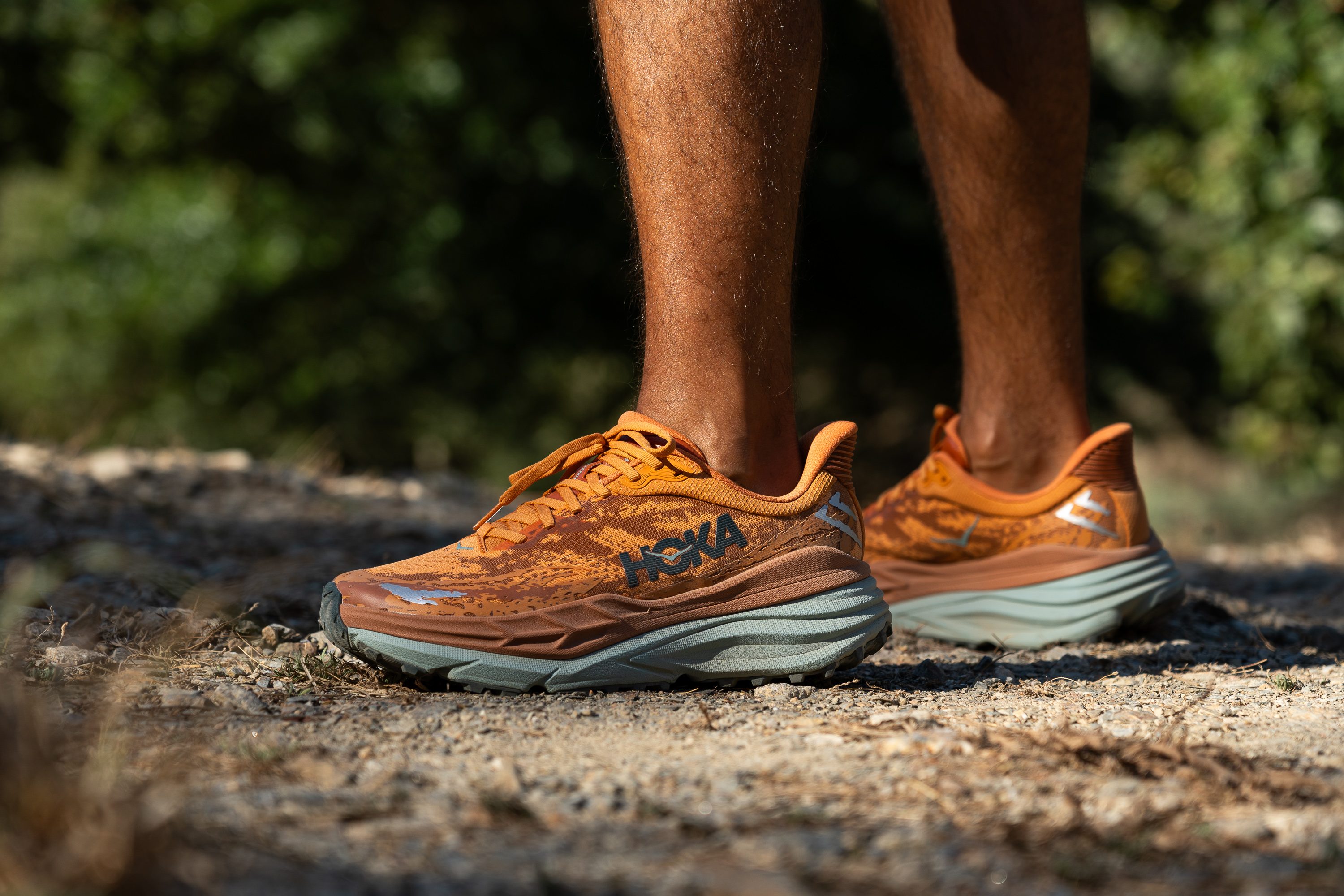
Who should NOT buy
The sheer weight of the Stinson 7 precludes it from being an efficient tempo trainer. For runners who want to go fast as well as far, we suggest the Salomon Ultra Glide 2 instead. An Argument can also be made for the similarly immense New Balance Fresh Foam X More Trail v3 which feels significantly lighter underfoot.
Runners with broad feet should look away as the toebox is pretty snug despite the Stinson 7’s wide base. This issue is exacerbated as our feet swell towards the end of long runs, making hotspots and blisters an inevitability rather than a possibility. For a shoe with a more accommodating toebox, we recommend checking out the New Balance Fresh Foam X Hierro v6.
The lugs on the Stinson 7 aren’t aggressive or durable enough to tackle more and technical terrains. We recommend checking out the Brooks Caldera 6 as a more rugged hybrid alternative, while those looking to tame the wildest trails should consider the Hoka Speedgoat 5 or the carbon-plated Tecton X 2 instead.
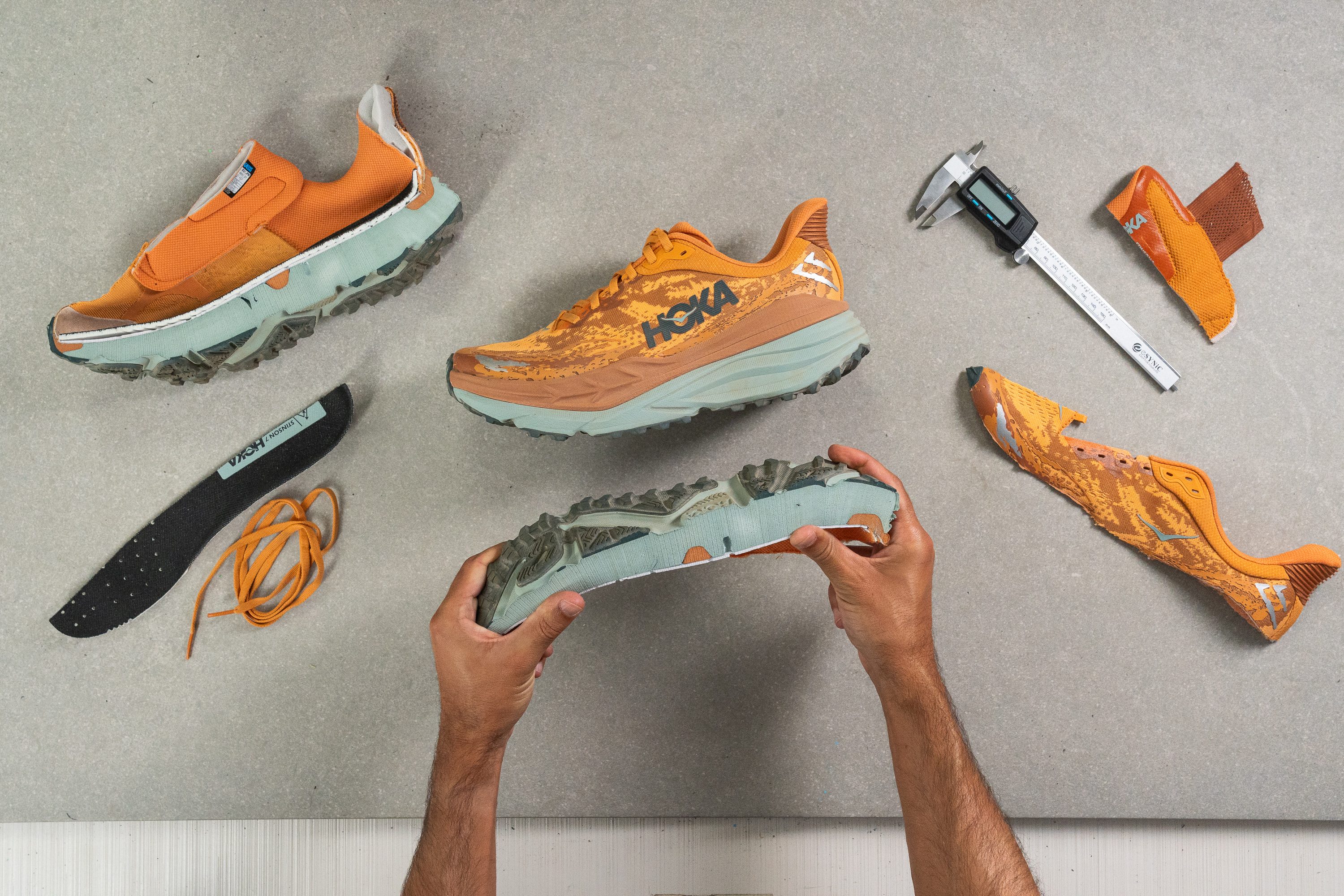
Cushioning
Shock absorption
Shock absorption is decent at 115 SA, but definitely a bit less cushioned than the shoe’s oversized look suggests. On the other hand, midfoot and forefoot strikers get good protection with 117 SA, better than most shoes on the market.
Does that sound odd? Well, keep in mind that most shoes offer noticeably less shock absorption in the front than in the rear.
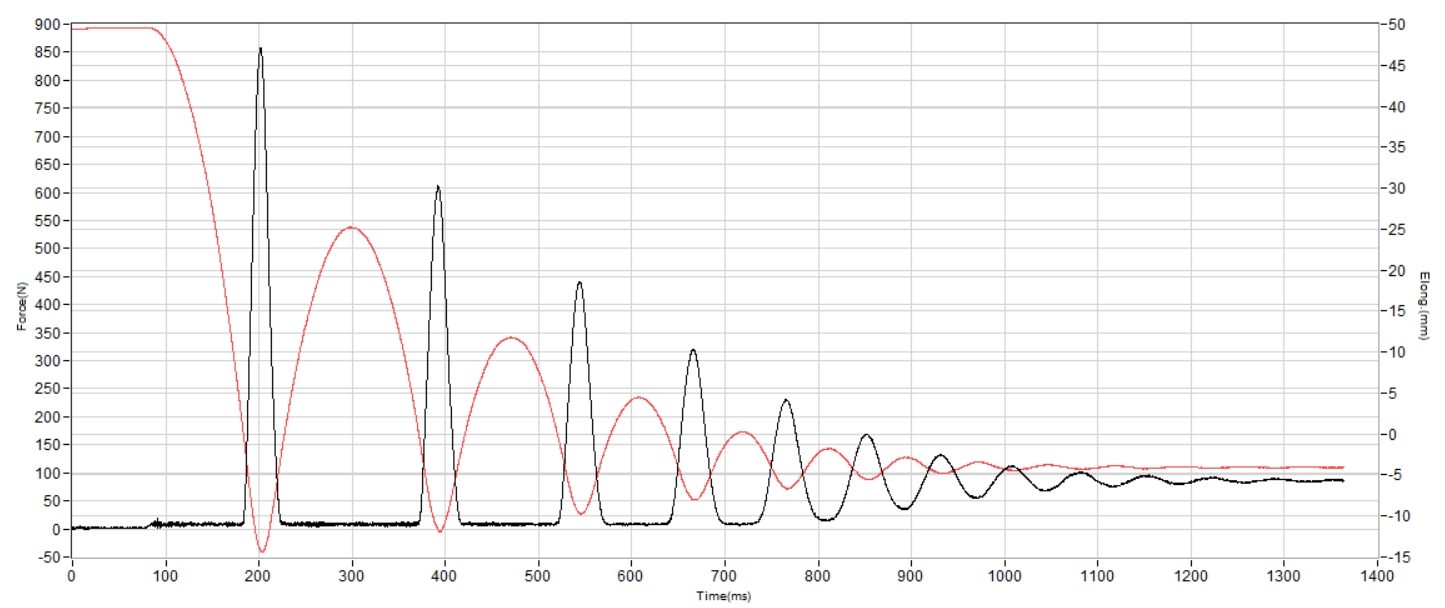
| Hoka Stinson 7 | 115 SA |
| Average | 122 SA |
Energy return
One advantage the Stinson 7 has over the Speedgoat 6 is energy return. While it may not look lively from the outside, our lab testing revealed the truth... it’s bouncier! It reached 55.6%, which isn’t groundbreaking compared to other shoes but, of course, that was expected from an EVA-based foam.
| Hoka Stinson 7 | 55.6% |
| Average | 55.6% |
Heel stack
Towering at 40 mm high according to our calliper, the Stinson 7 boasts a Goliath of a heel stack that far exceeds our current lab average.

Surprisingly though, wearing the Stinson 7 doesn’t feel like running in a stiletto as the midsole utilises what Hoka calls “active foot frame technology”. This allows our foot to sink into the midsole and feel cradled by the foam rather than just sitting on top of it.
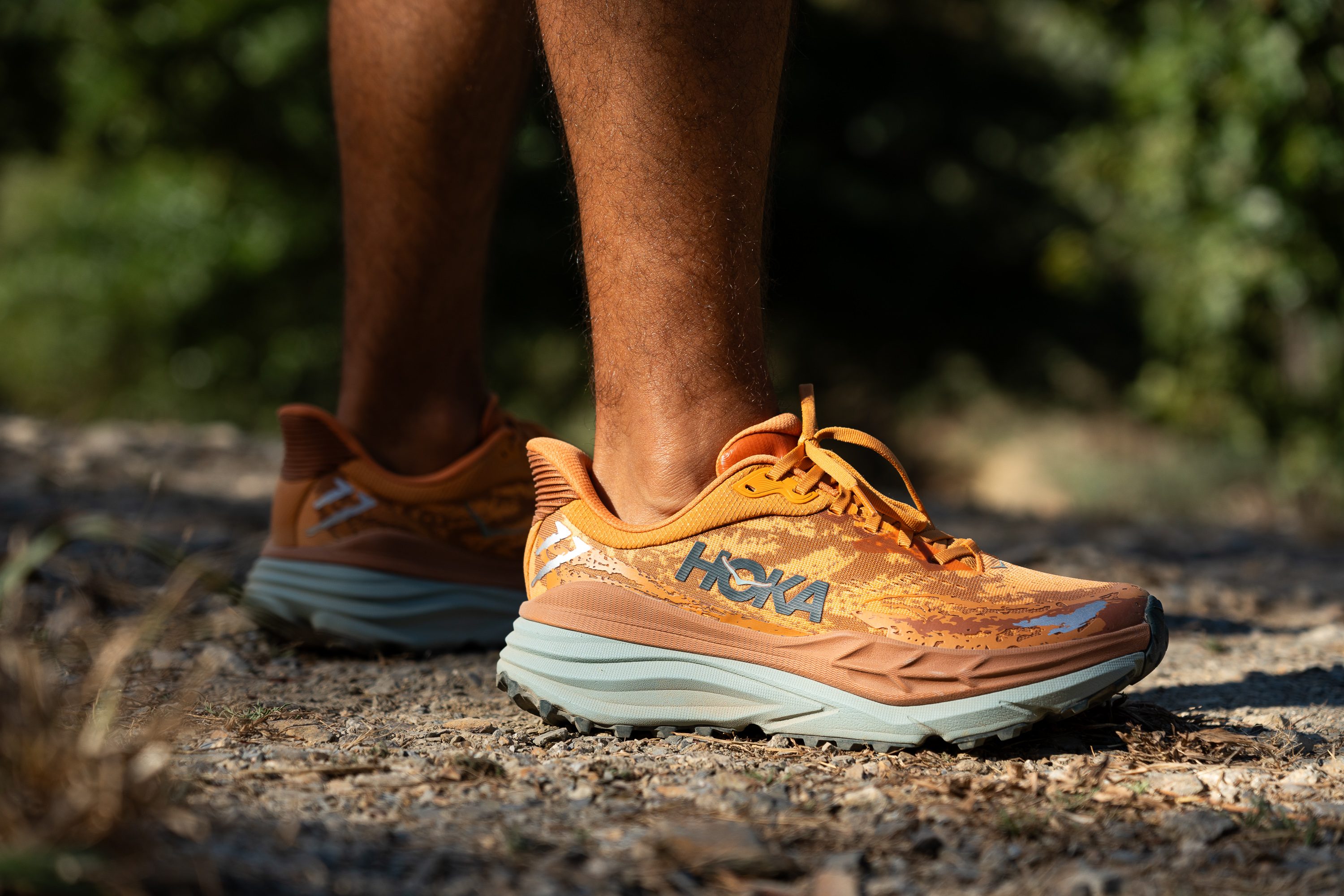
| Hoka Stinson 7 | 40.0 mm |
| Average | 32.6 mm |
Forefoot stack
At 33 mm according to our calliper measurements, the Stinson 7’s forefoot stack is taller than the average trail shoe both at the forefoot and the heel. This means that there is plenty of foam underfoot to ensure well protected forefoot landings over any distance.
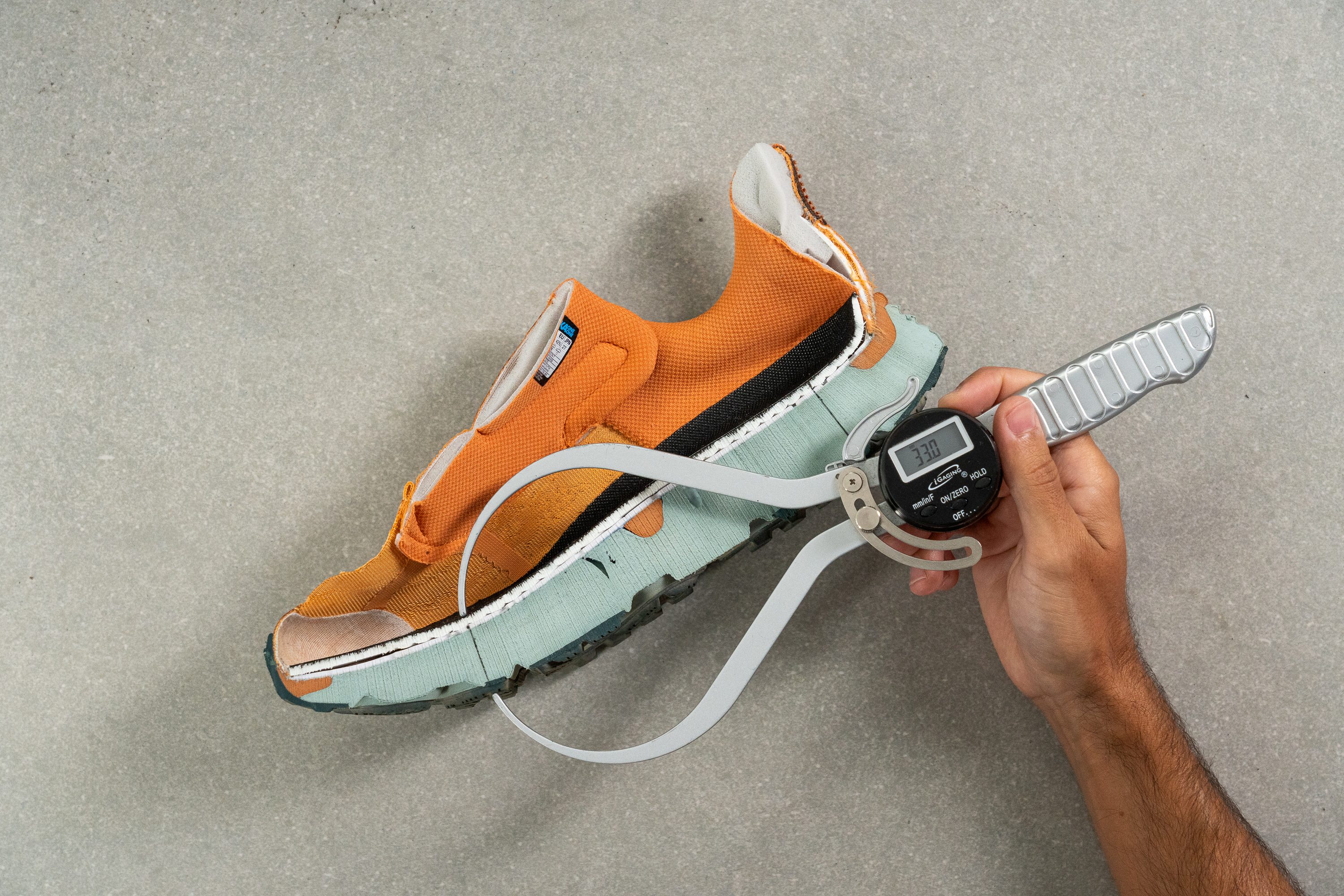
The Stinson 7 is about as maximalist a trail shoe as you can get which will take some getting used to, especially for runners accustomed to more traditional stack heights. Those who prefer feeling more grounded on their runs should consider the Brooks Cascadia 17 instead.
| Hoka Stinson 7 | 33.0 mm |
| Average | 25.1 mm |
Drop
Although officially advertised as having a 5 mm drop, the difference in our accurate stack measurements leaves us with an actual heel drop of 7 mm. This still classifies the Stinson 7 as a mid drop shoe which is suitable for most runners and running styles.
While the disparity in the Stinson 7’s drop height is something only highly attuned runners will notice, this can’t be said for many of the shoes we’ve tested where we found much larger discrepancies with the official specs. This guide delves into the matter using data we’ve recorded in the lab.
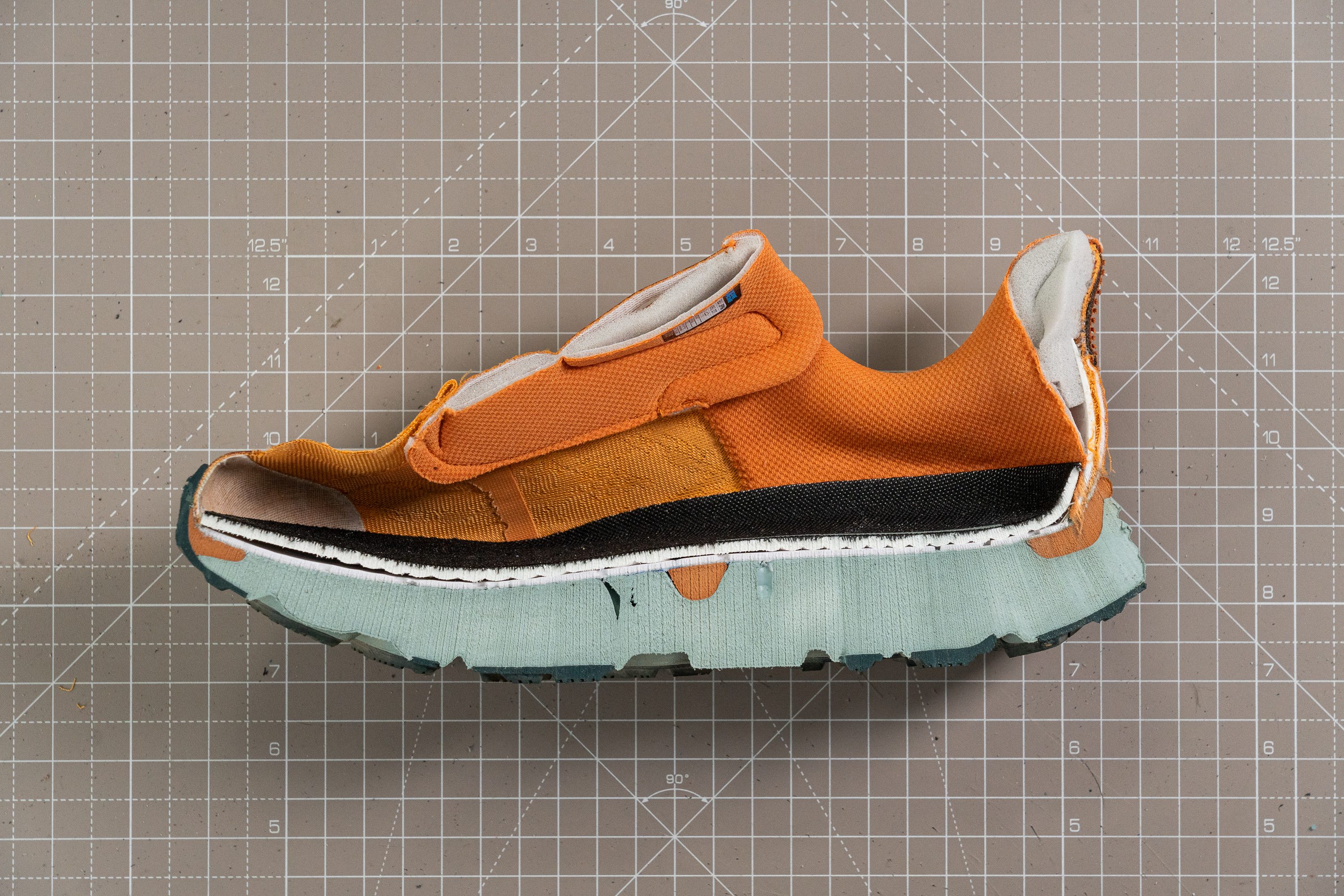
| Hoka Stinson 7 | 7.0 mm |
| Average | 7.5 mm |
Midsole softness
We pressed our durometer against the Stinson 7’s midsole and got a reading of 18.9 HA, which is much softer than our current lab average for trail shoes.
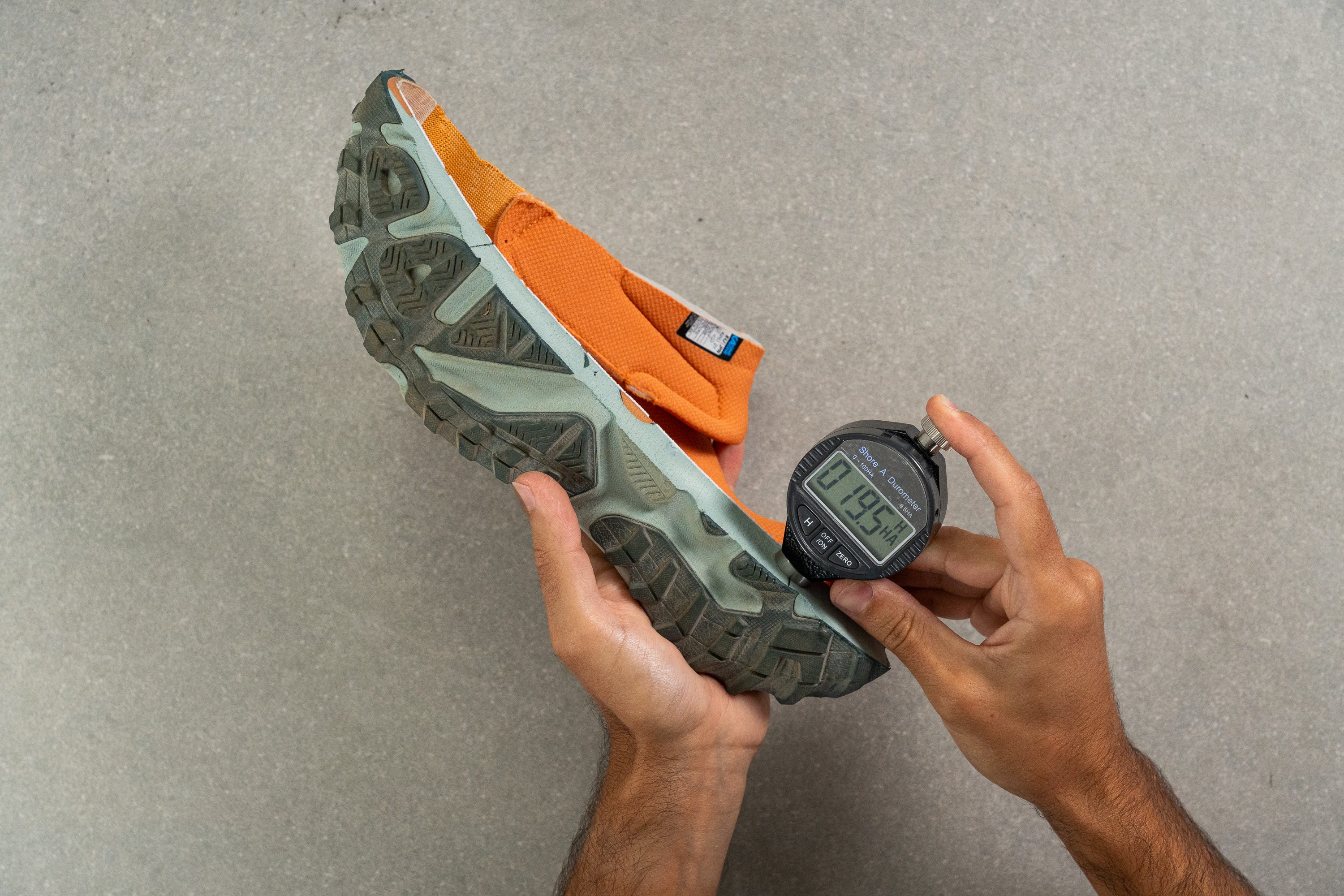
Despite being decidedly plush, the Stinson never bottomed out on us or felt overly squishy during our runs.
This is thanks in part to the shoe’s robust stack as well as the makeup of the foam which is responsive enough to provide good rebound without the bounciness or springiness found in other maximalist shoes. The Stinson 7 also features a mildly rockered design that promotes smooth transitions, resulting in a buttery and well-cushioned ride that had us feeling pampered as we eased past our mile markers
| Hoka Stinson 7 | 18.9 HA |
| Average | 21.9 HA |
Size and fit
Size
Hoka Stinson 7 fits true to size (120 votes).
Width / Fit
Using our calliper, we measured the Stinson 7’s width to be 96.6 mm.
While this aligns with our current lab average, we wouldn’t call the shoe roomy, though by Hoka standards, it is!
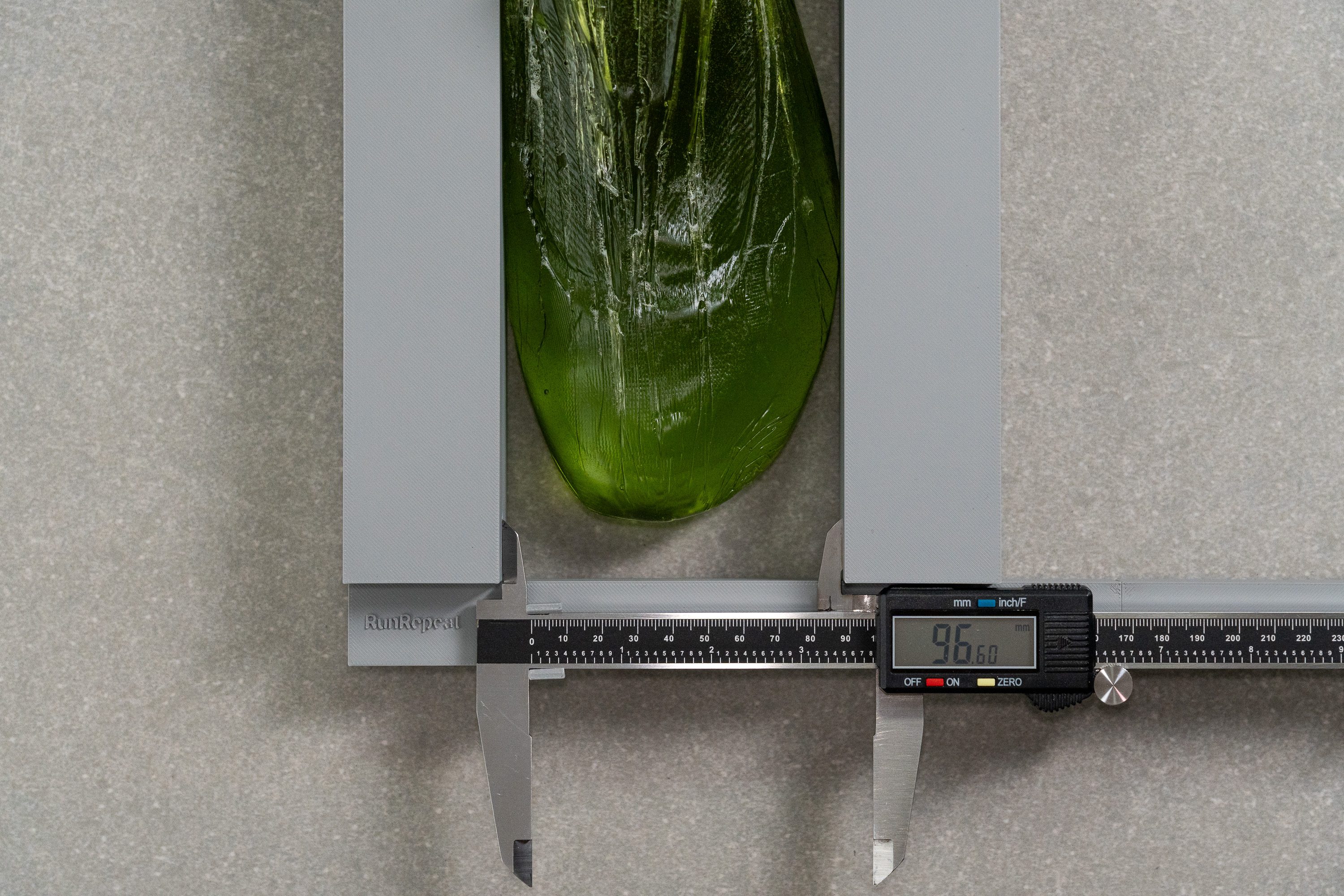
| Hoka Stinson 7 | 96.6 mm |
| Average | 95.6 mm |
Toebox width
Moving up to the area around the big toe, the Stinson 7’s toebox is also around lab average at 74.8 mm according to our caliper. This means that runners with narrow to normal-width feet will have enough room for natural toe splay without feeling too constricted.
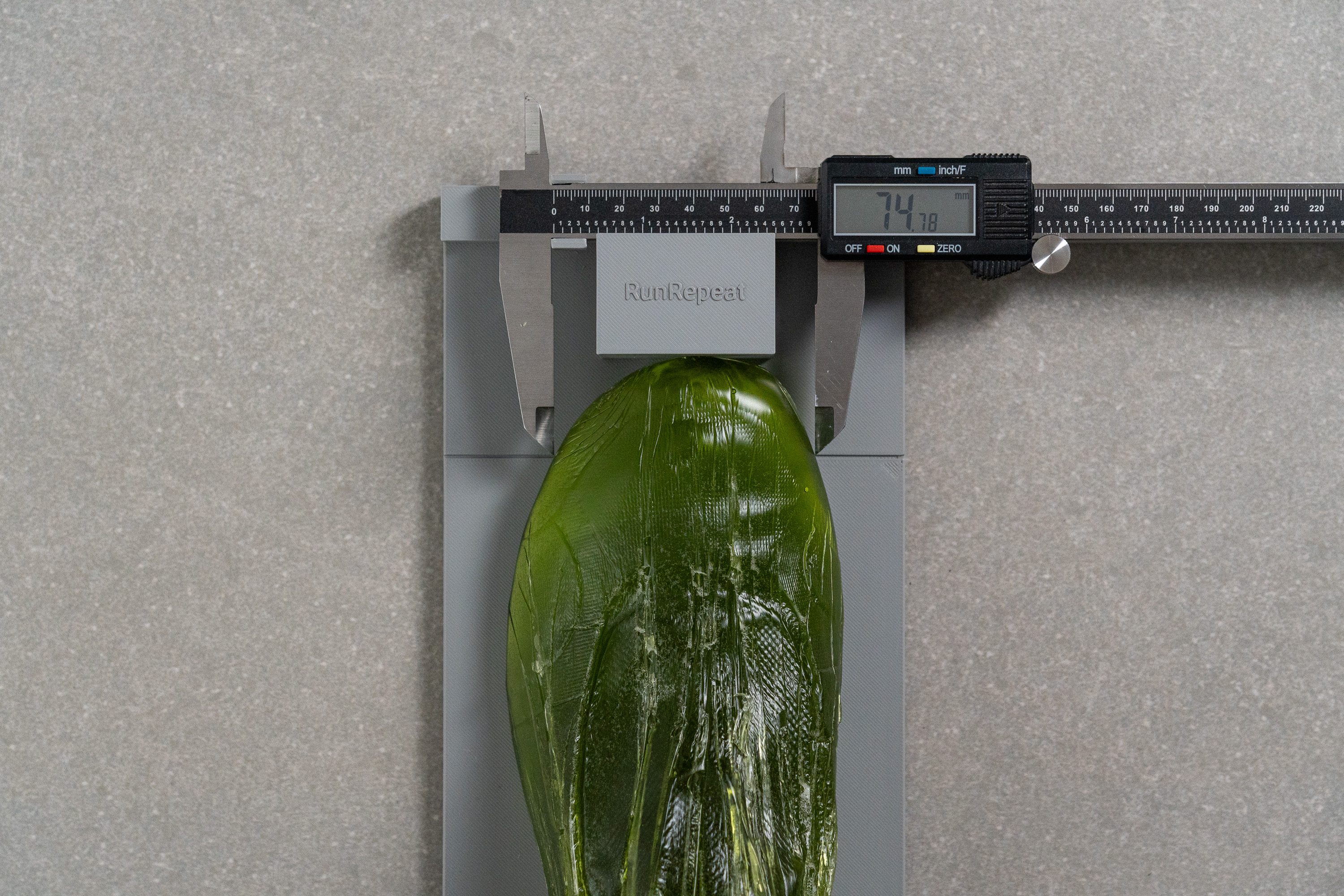
| Hoka Stinson 7 | 74.8 mm |
| Average | 74.6 mm |
Toebox height
Adding to the surprising findings, we discovered that the toebox height exceeded the average for trail shoes at 28.3 mm. This is fantastic for long-day adventures, accommodating foot swelling and allowing ample toe movement.
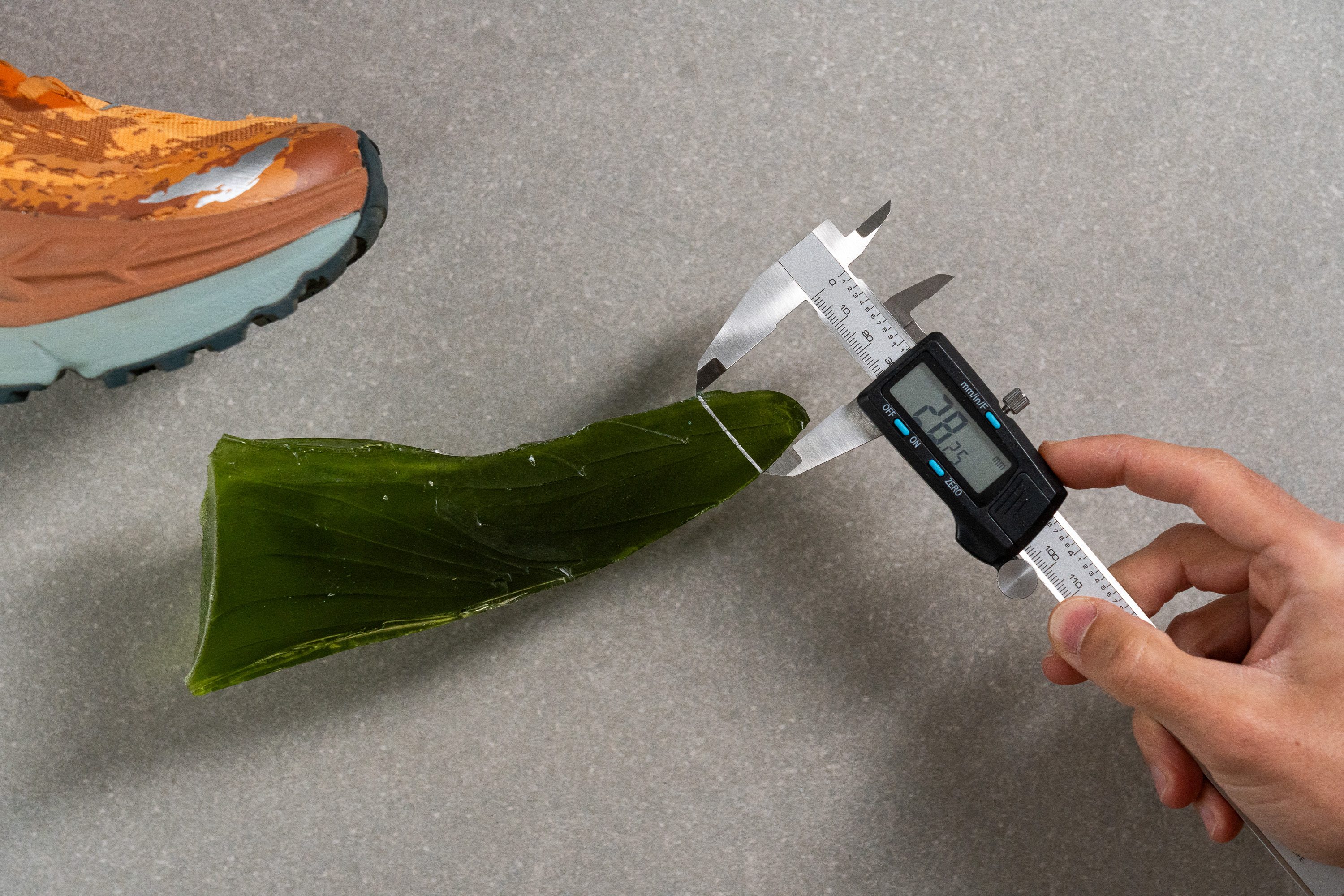
| Hoka Stinson 7 | 28.3 mm |
| Average | 27.1 mm |
Traction / Grip
Forefoot traction
The Stinson 7 is a heavy-duty shoe, so solid grip is especially important given its greater inertia compared to lighter models. We found a 0.37 result in our lab test, which is enough to feel confident underfoot, though slightly below what we hoped for in such a max-cushioned design.
| Hoka Stinson 7 | |
| Average | 0.61 |
Lug depth
We measured the Stinson 7’s lugs with our calliper to be 3.0 mm thick which, despite being a little shorter than average, provided us with great traction whether we took it on the road or through dirt, gravel or even slightly muddy trails. Very technical trails or ones with lots of soft mud, however, are definitely too much for the shoe’s subtle lug configuration.
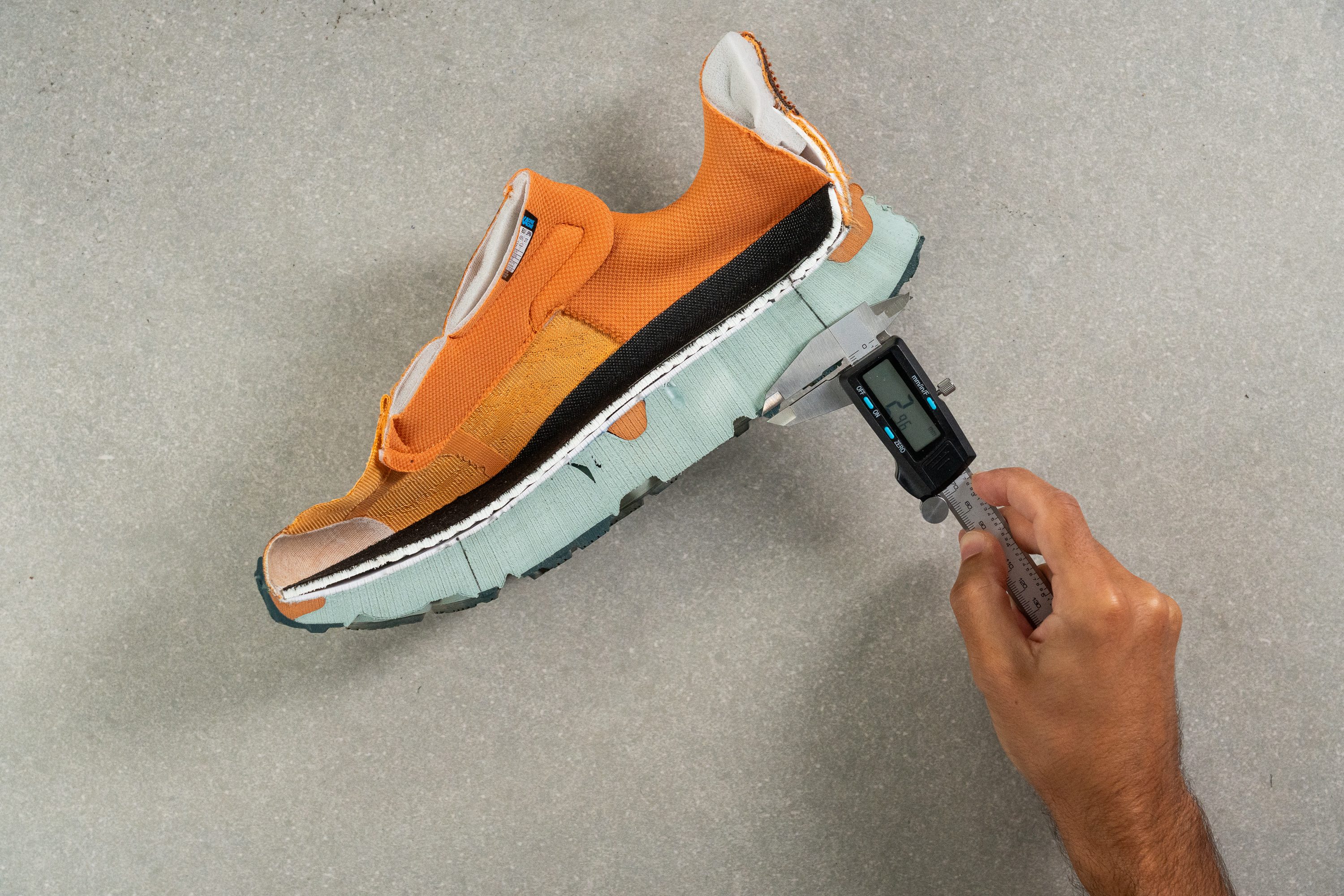
| Hoka Stinson 7 | 3.0 mm |
| Average | 3.5 mm |
Outsole design
The outsole of the Stinson 7 uses a zonal rubber pattern with strategic placements at the heel, forefoot, and outer edges. However, due to its max-stack geometry, the design includes significant exposed foam in the midfoot and central areas, which also reduces grip. Flex grooves and cutouts help maintain some adaptability, but rubber coverage is noticeably lower than in other trail models.
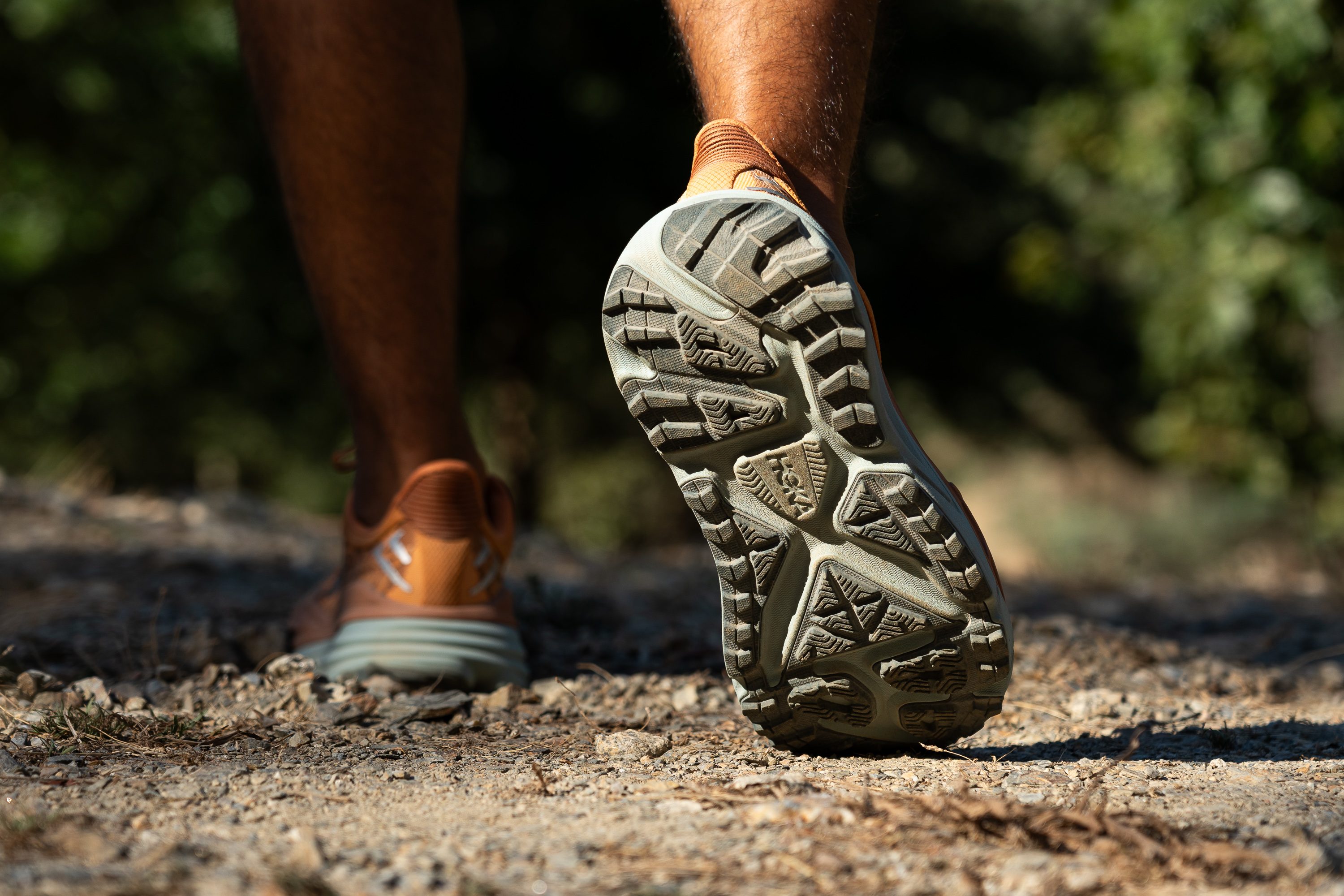
Flexibility / Stiffness
To see how flexible the shoe is, we secured the Stinson 7 to our machine and measured the amount of force required to bend the shoe 30-degrees. With a reading of 23.6N, the Stinson 7 is a quite stiffer than the average trail shoe.
While this level of stiffness means that the shoe does resist the natural movement of our foot to a certain extent, it also adds some responsiveness and a propulsive feeling to the shoe.
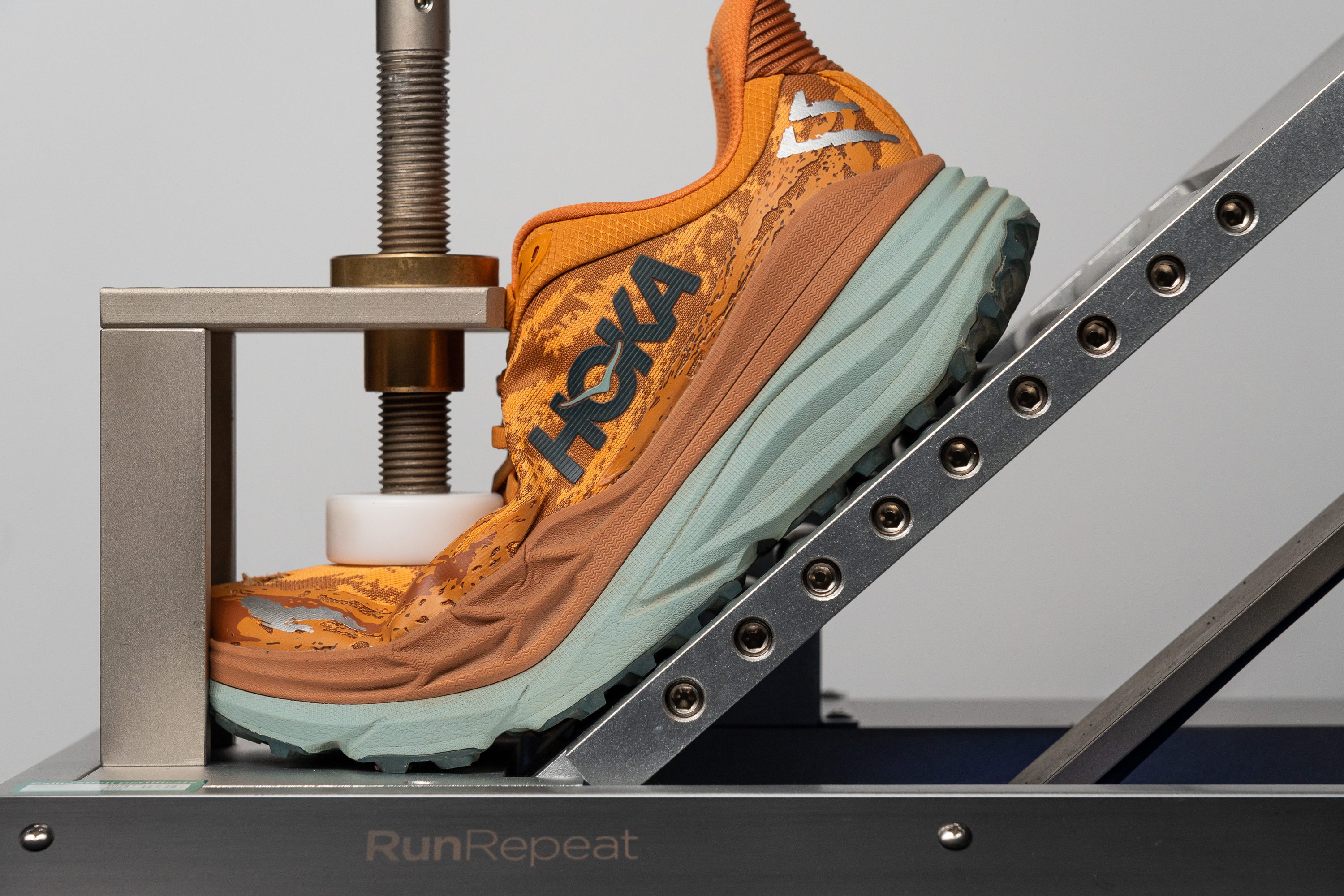
| Hoka Stinson 7 | 23.6N |
| Average | 14.7N |
Stiffness in cold (%)
We repeated our stiffness test after having left the Stinson 7 in the freezer for twenty minutes and found that the shoe requires 46.2N of force to bend 90 degrees after being exposed to cold conditions. This is a stiffer result than our lab average, so the shoe will definitely feel less pliable during frosty winter runs.
The Stinson 7 becomes only 37.7% less flexible when exposed to cold weather conditions, making it more consistent than the average trail shoe. This means that while the Stinson 7 does stiffen up in cold conditions, it should still feel more or less like the same shoe rather than turning into an icy plank.
| Hoka Stinson 7 | 38% |
| Average | 32% |
Weight
The Stinson 7 is as chunky as it looks, tipping our scale at a bulky 12.1 Oz (342g) which is significantly heavier than the average trail shoe. This means that the Stinson 7 does take some getting used to as it feels a little like running with ankle weights on. This also makes the Stinson 7 a less than ideal choice for tempo sessions.
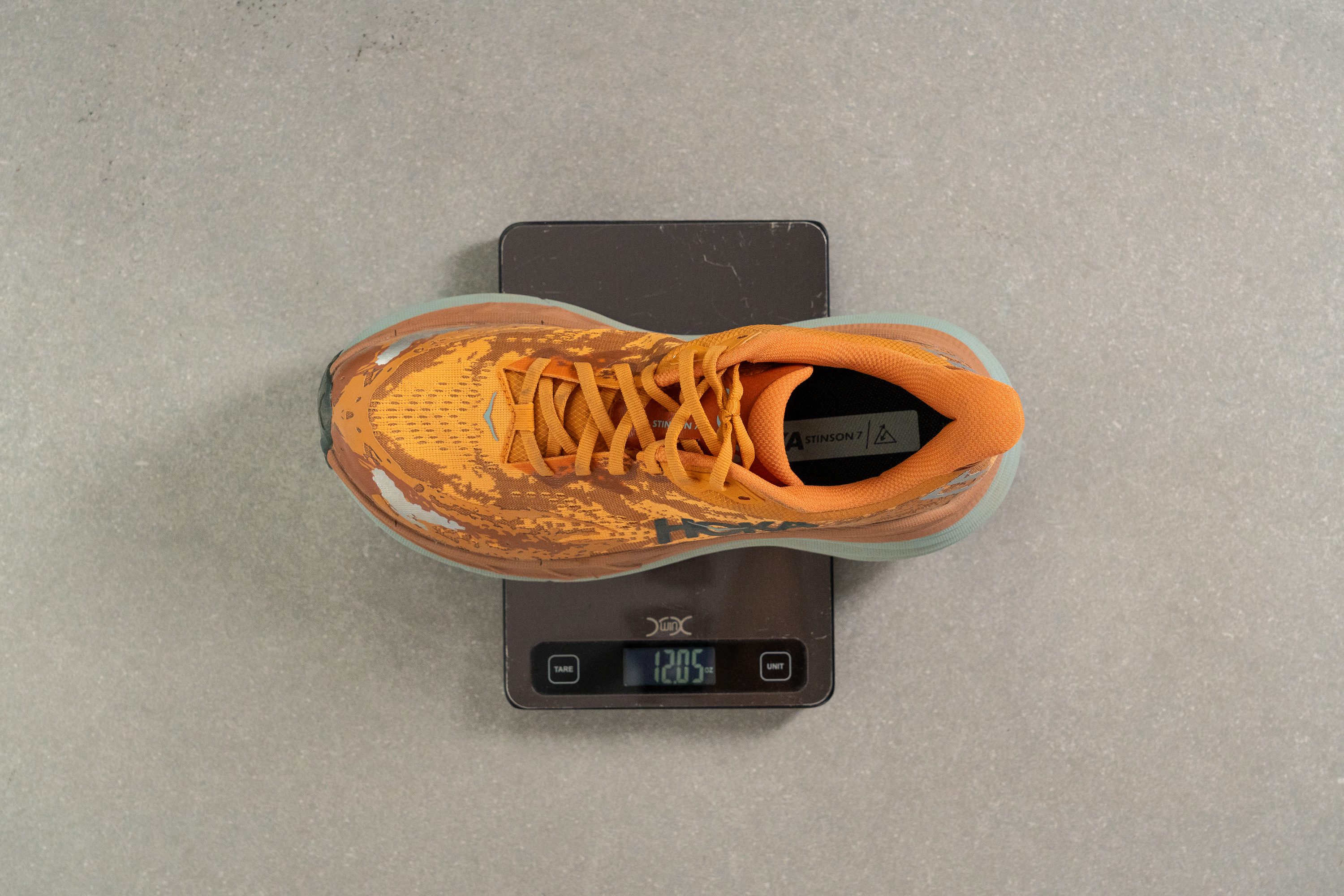
| Hoka Stinson 7 | 12.1 oz (342g) |
| Average | 10.2 oz (289g) |
Breathability
To test the breathability of the shoe, we pumped the Stinson 7 full of smoke and observed how it escapes the shoe over a period of ten seconds. As we can see from the, the Stinson 7 lets out the smoke almost immediately and in a slow and steady fashion throughout the shoe, earning it a score of 4 out of 5. This makes the Stinson 7 a good choice even during more sweltering summer runs.
Looking at a backlit cross section of the shoe’s upper, we can see quite a number of places that heat is able to escape through based on how easily the light shines through those sections.
Our closeup shots of the Stinson 7’s upper mesh shows us that while the top is rather densely woven, it gives way to a more airy formation underneath which promotes airflow throughout the shoe.


| Hoka Stinson 7 | 4 |
| Average | 3.2 |
Stability
Lateral stability test
In spite of the shoe’s immense stack, the Stinson 7 felt incredibly well grounded when we shifted our weight from side to side. This is thanks to the shoe’s burly base and the midsole’s aforementioned “active foot frame technology” that envelopes our foot in the midsole rather than perching precariously above it.
Torsional rigidity
The Stinson 7 didn’t give in at all when we tried twisting and manipulating it in our hands, leading us to give it a torsional rigidity score of 5 out of 5 on our subjective scale. This isn’t surprising for a shoe with so much foam underfoot, but does mean that the shoe doesn’t contort with the natural movement of the foot during our stride.
The rigidity of the Stinson 7 also factors into its remarkably stable nature, with the shoe barely giving in to us attempting to bend and twist it in our hands, thus earning the Stinson 7 a score of 5 out of 5 on our subjective scale for torsional rigidity. This feature serves to offset any tippiness we might experience on such a high stack by mitigating any side-to-side movement of our foot.
| Hoka Stinson 7 | 5 |
| Average | 3.6 |
Heel counter stiffness
We also faced a lot of resistance when attempting to manipulate the Stinson 7’s heel counter by pushing and squeezing at it, leading us to give the shoe a score of 5 out of 5 for heel counter stiffness. This level of stiffness serves to lock our heel in place and prevent any excessive rolling of the ankle. This also provides us with good rearfoot stability which is not only beneficial for heel striking runners, but also those with mildly pronating strides.
| Hoka Stinson 7 | 5 |
| Average | 3 |
Midsole width - forefoot
The Stinson 7’s midsole is a beast not just in its height, but width too. We measured the midsole at a frankly insane 124.3 mm wide at the forefoot. This is much wider than our current lab average and means that we have an extremely wide base that ensures stable landings and toe offs. The only drawback to having such a girthy midsole is that the Stinson 7 does feel a little blocky when cornering, but since going fast in this heavy shoe isn’t really an option, we don’t think that this is a dealbreaker by any means.
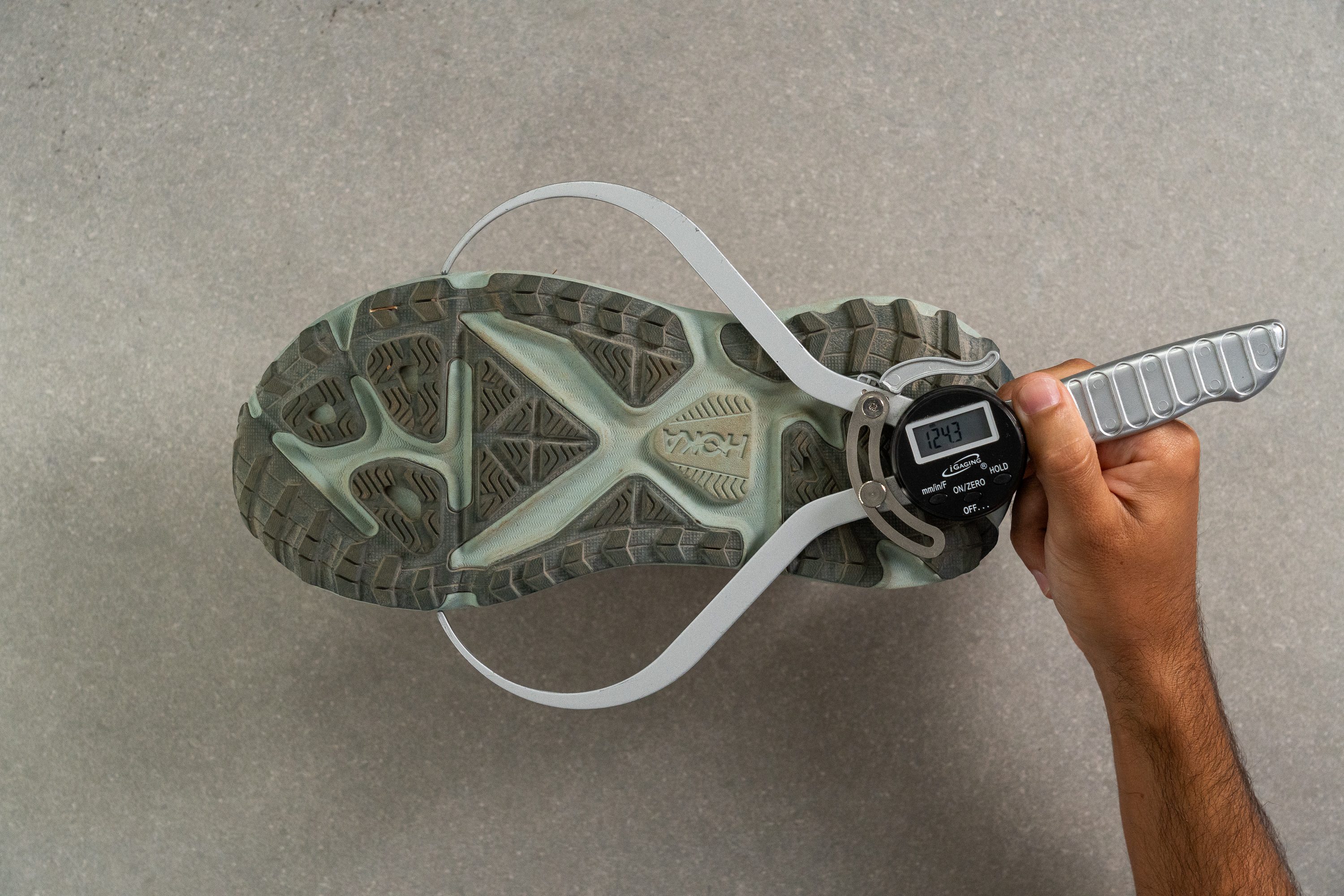
| Hoka Stinson 7 | 124.3 mm |
| Average | 112.8 mm |
Midsole width - heel
Moving down to the heel, the Stinson 7’s midsole is still much wider than our current lab average, measuring 100.2 mm wide. This means that heel strikers will also have an extremely stable landing platform despite the shoe’s exceptionally high heel stack.

| Hoka Stinson 7 | 109.3 mm |
| Average | 89.9 mm |
Durability
Toebox durability
We turn to our trusty dremel to test the toughness of the Stinson 7’s toebox by applying it to the shoe at 5K RPM with a force of 3.2N. The tool’s grinding element immediately bites into the mesh and starts shredding away with ease. By the end of the four second test, we had ripped open a rather unsightly hole large enough to let little bits of debris into the shoe. We therefore give the Stinson 7 a toebox durability score of 1 out of 5, and recommend being careful if out on more rugged trails with lots of snagging hazards as one unlucky snag will put the shoe into early retirement.
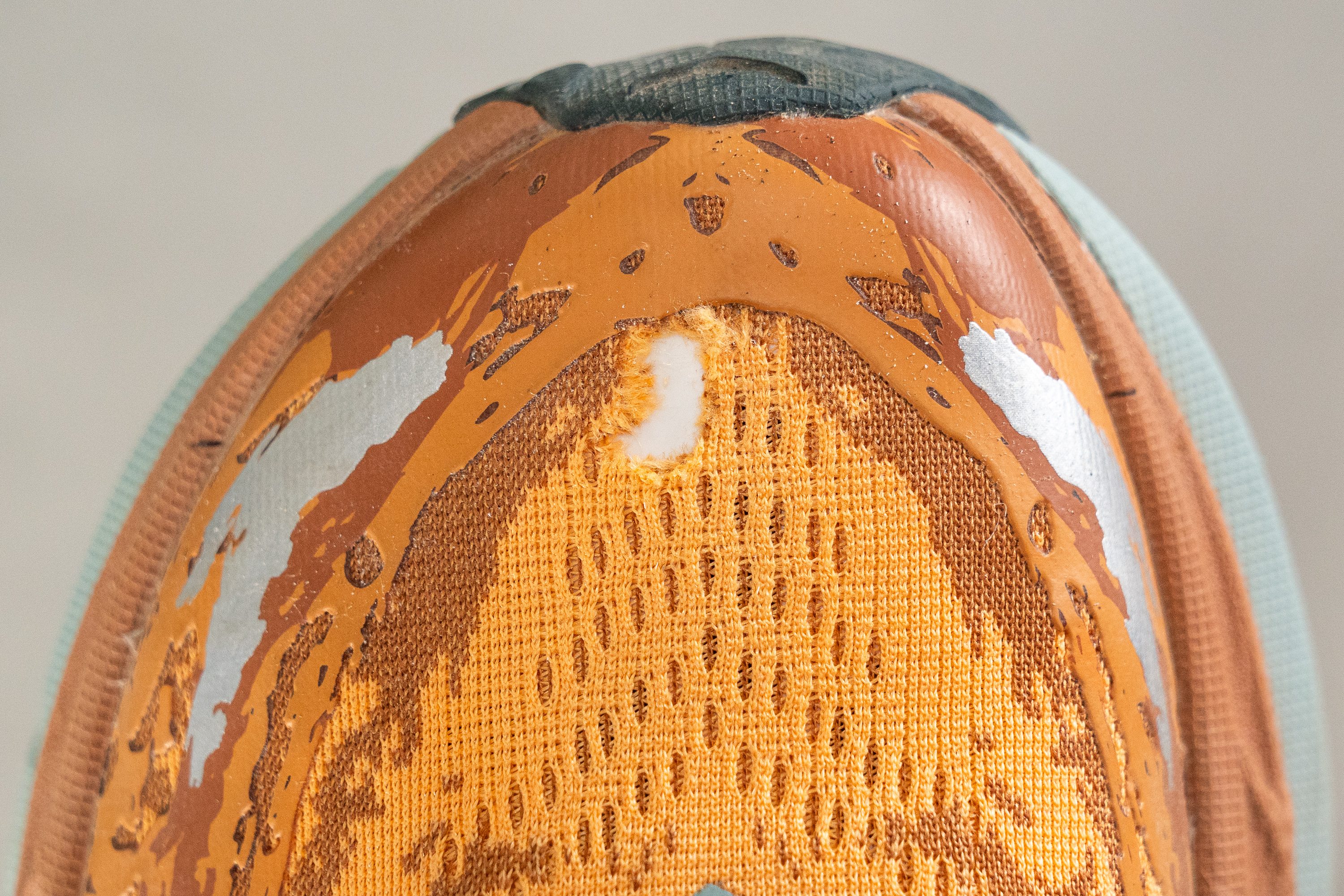
For a road-to-trail shoe with a more durable toebox, we recommend checking out the Nike Terra Kiger 9 instead.
| Hoka Stinson 7 | 1 |
| Average | 3.1 |
Heel padding durability
The heel counter didn’t fare much better against our dremel which, under the same parameter as our last test, blew through the shoe’s inner lining and much of the soft padding underneath. This lacklustre performance earns the heel padding a durability score of 1 out of 5, meaning we wou;dn’t recommend going sockless in the Stinson 7 as repeated friction from our sweaty heels will eventually wear aways at the padding and compromise the shoe’s rearfoot comfort and lockdown.
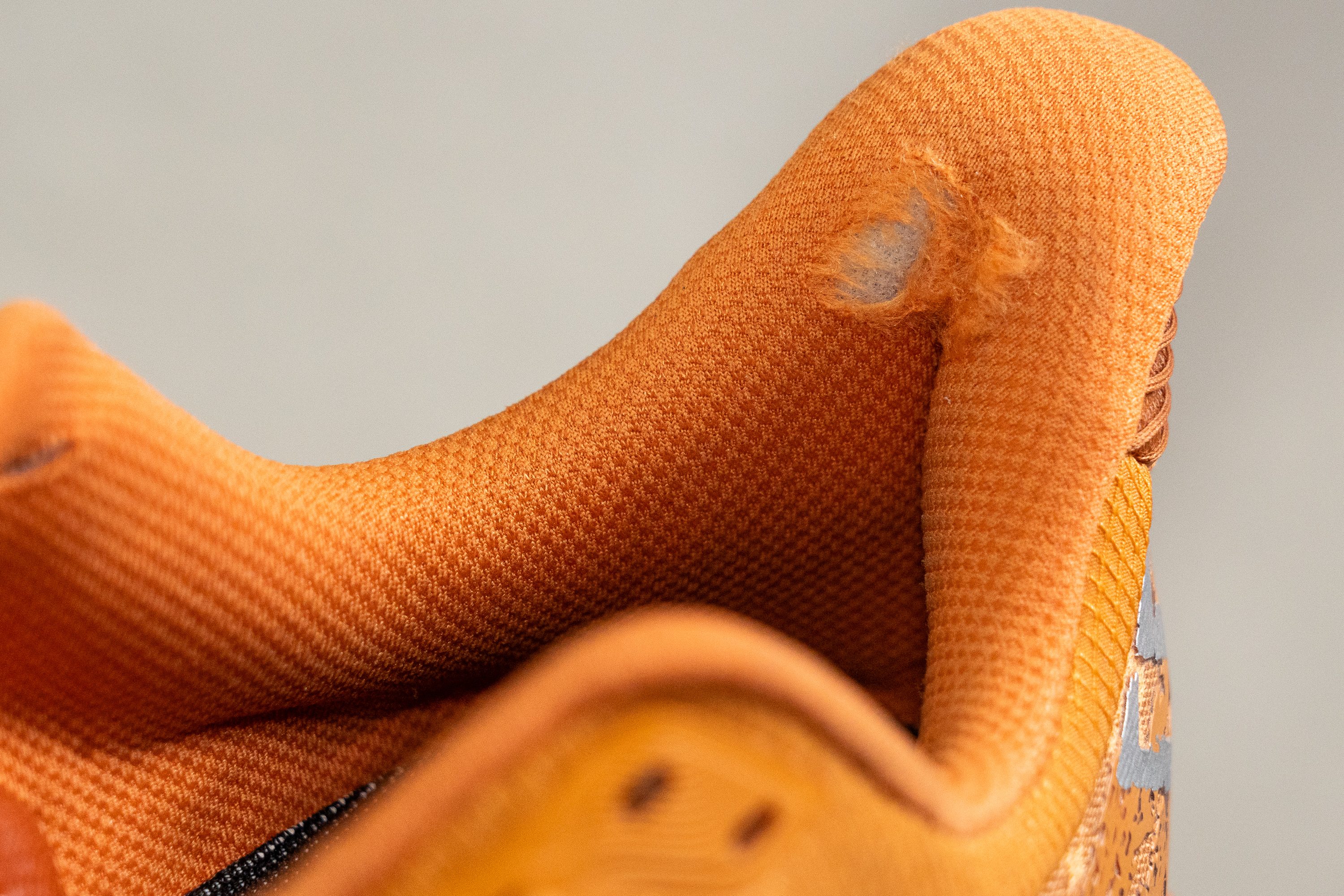
| Hoka Stinson 7 | 1 |
| Average | 3 |
Outsole hardness
We used our durometer to measure how hard the outsole material is and got a result of 82.6 HC. While this is slightly softer than our current lab average for trail shoes, this level of hardness is still a good balance between soft and grippy versus hard and durable.

| Hoka Stinson 7 | 82.6 HC |
| Average | 85.8 HC |
Outsole durability
To test how durable the Stinson 7’s outsole really is, we again turned to our dreaded dremel and pressed it against the shoe at 10K RPM with a force of 3.2N. While the footage does look pretty dramatic, by the end of the twenty second test we measured a loss of 1.06 mm of material which is only ever-so slightly more than the average trail shoe loses after running the same test. This means that the Stinson 7’s outsole is quite durable and should last easily 400 miles, albeit with some signs of wear and tear by then.

| Hoka Stinson 7 | 1.1 mm |
| Average | 0.9 mm |
Outsole thickness
The Stinson 7’s outsole is slightly less thick than the average trail shoe, with our caliper measuring it out 2.1 mm. While a little more outsole material would definitely improve the longevity of the shoe, it would also make what is already a heavy shoe even heavier.
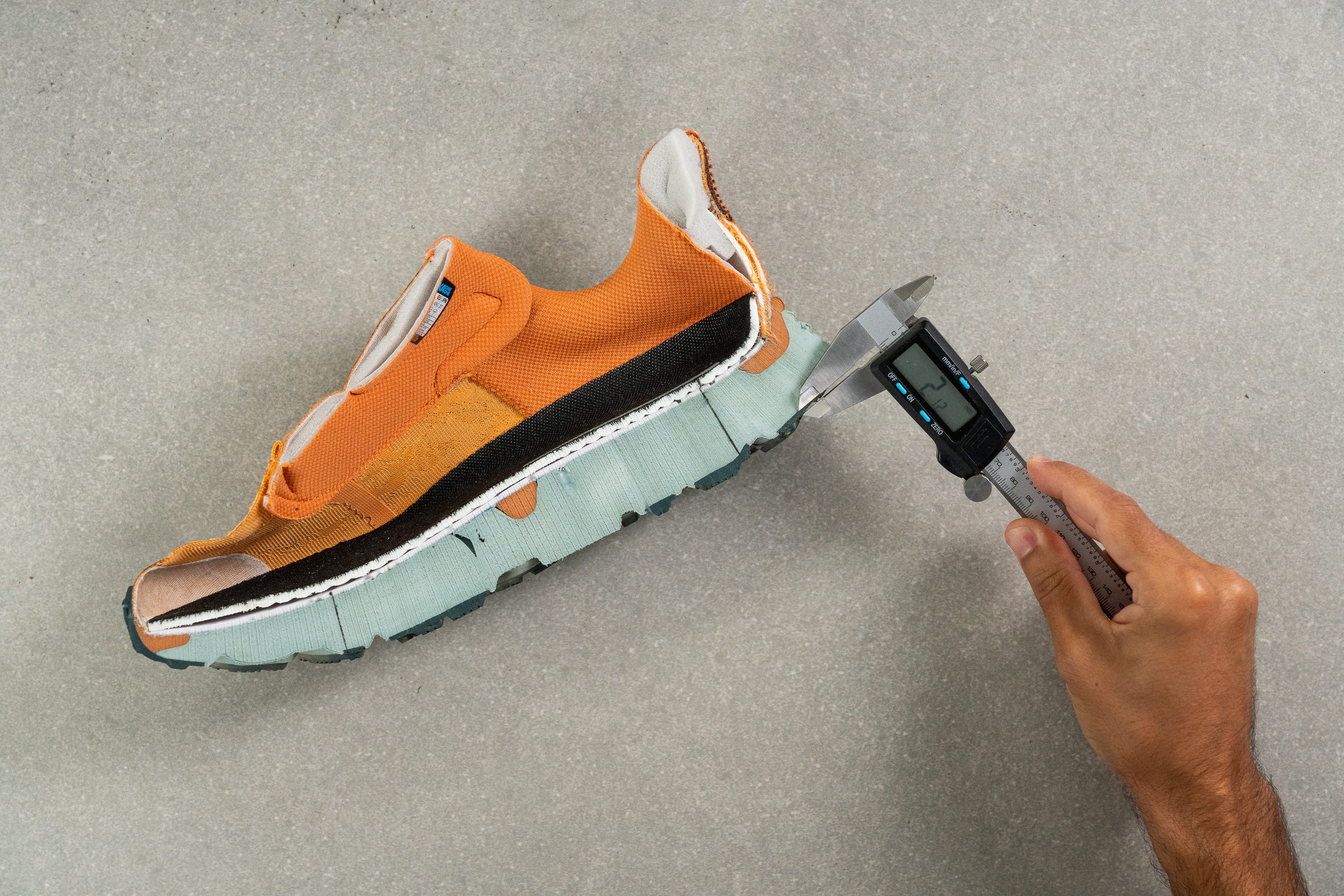
| Hoka Stinson 7 | 2.1 mm |
| Average | 2.2 mm |
Misc
Insole thickness
We measured the insole to be 3.7 mm thick which, while being slightly thinner than our current lab average, provided us with a padded enough landing surface that complements the Stinson 7’s midsole cushion.
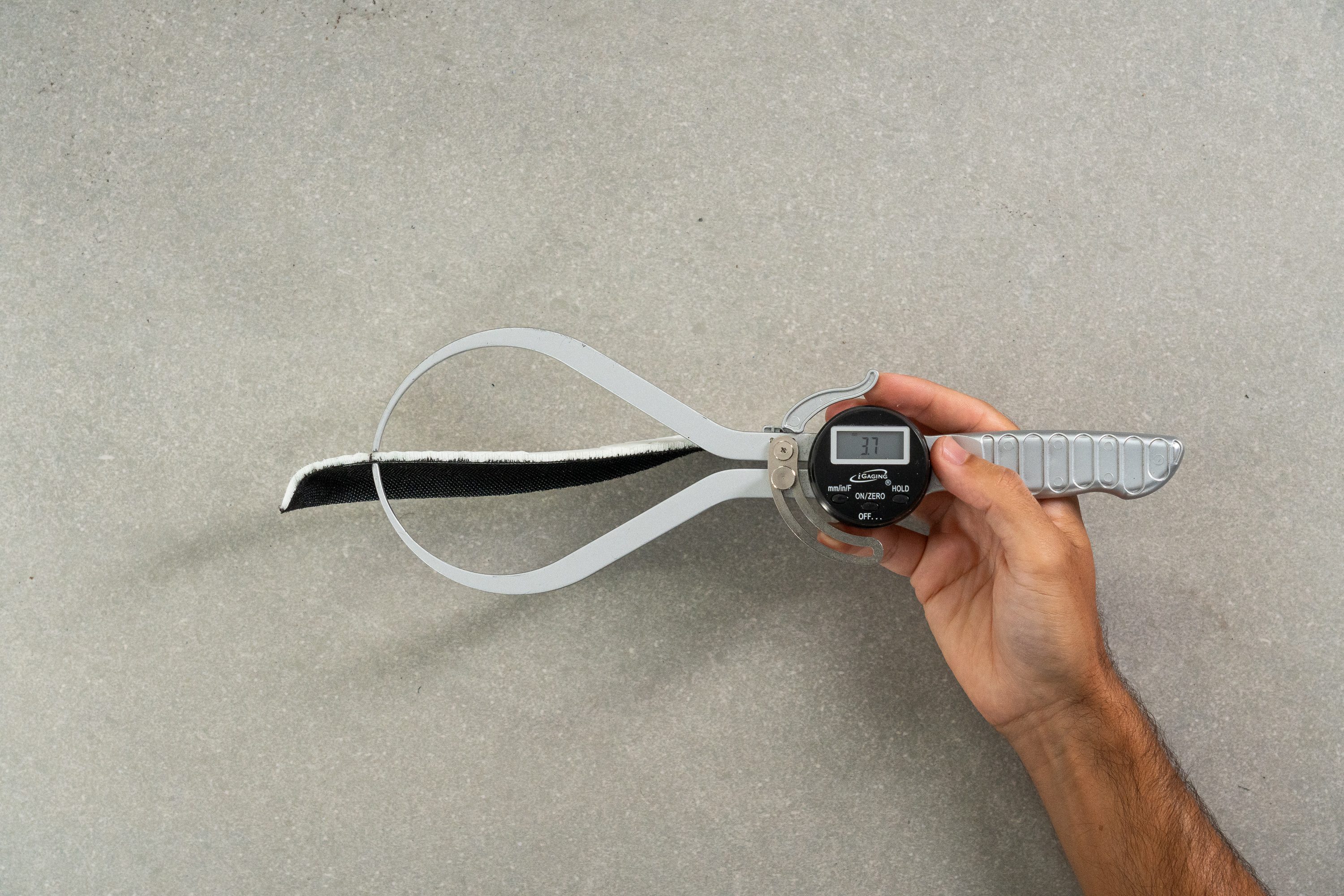
| Hoka Stinson 7 | 3.7 mm |
| Average | 4.7 mm |
Removable insole
The Stinson 7’s midsole is fully removable, so custom orthotics can be used with the shoe where necessary.
| Hoka Stinson 7 | Yes |
Midsole softness in cold (%)
To see how the midsole foam reacts to cold weather conditions, we left the Stinson 7 in the freezer for twenty minutes. We then repeated the softness test and got a durometer reading of 26.6 HA. While definitely on the firmer side of the spectrum, this is still softer than our current lab average and means that the Stinson 7 won’t freeze into ice blocks during winter runs.
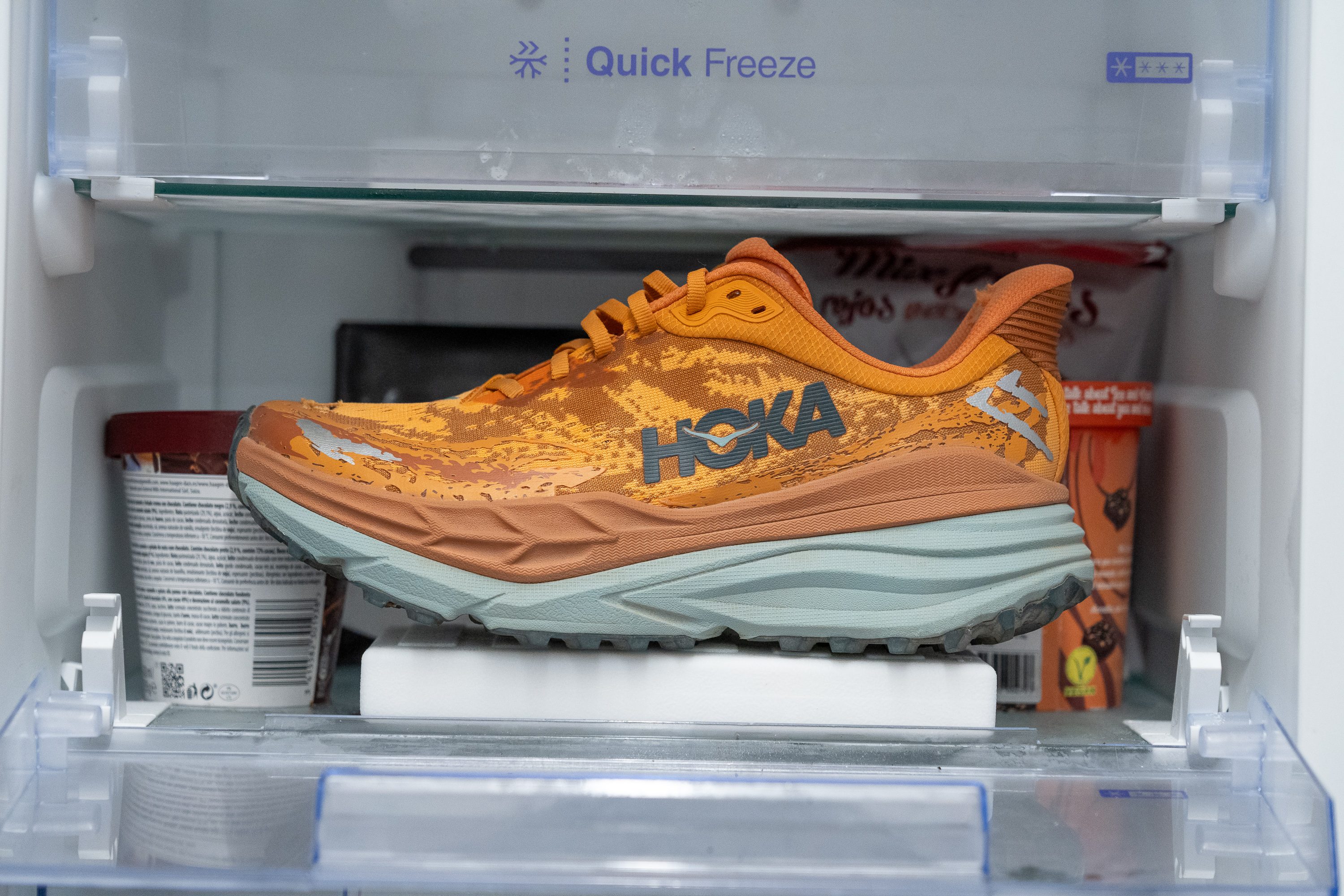
| Hoka Stinson 7 | 41% |
| Average | 26% |
Reflective elements
It may be a monster of a shoe, but the Stinson 7 certainly doesn’t go bump in the night. With no reflective elements whatsoever, we don’t recommend going for nocturnal runs without some form of high-visibility gear if veering away from well-lit areas.
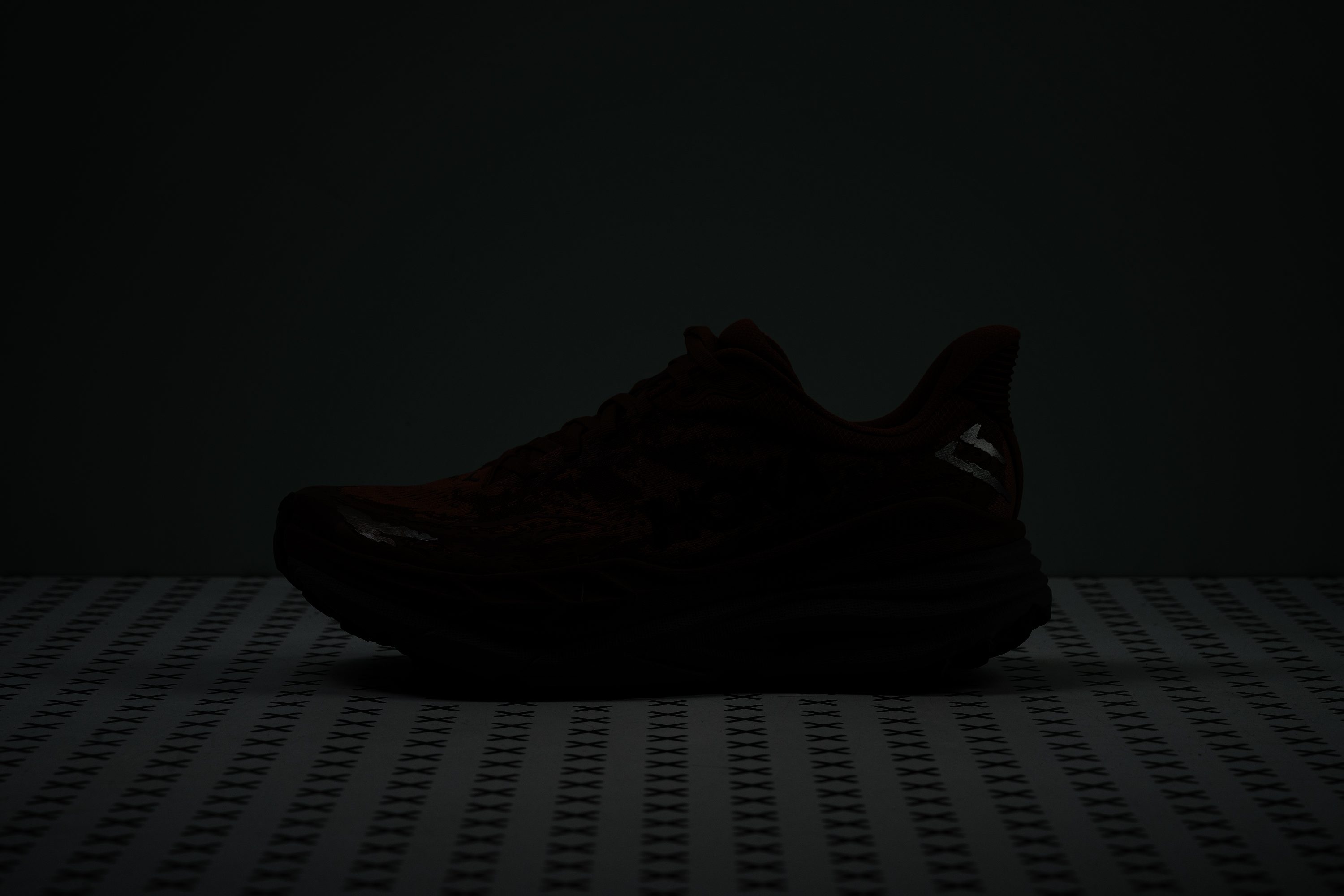
| Hoka Stinson 7 | No |
Tongue padding
In typical Hoka fashion, the Stinson 7’s tongue is generously padded at 8.7 mm thick which is notably more plush than the average shoe. This not only provided us with lots of comfort around the instep, but also aided in achieving a secure midfoot lockdown with no hint of lace bite
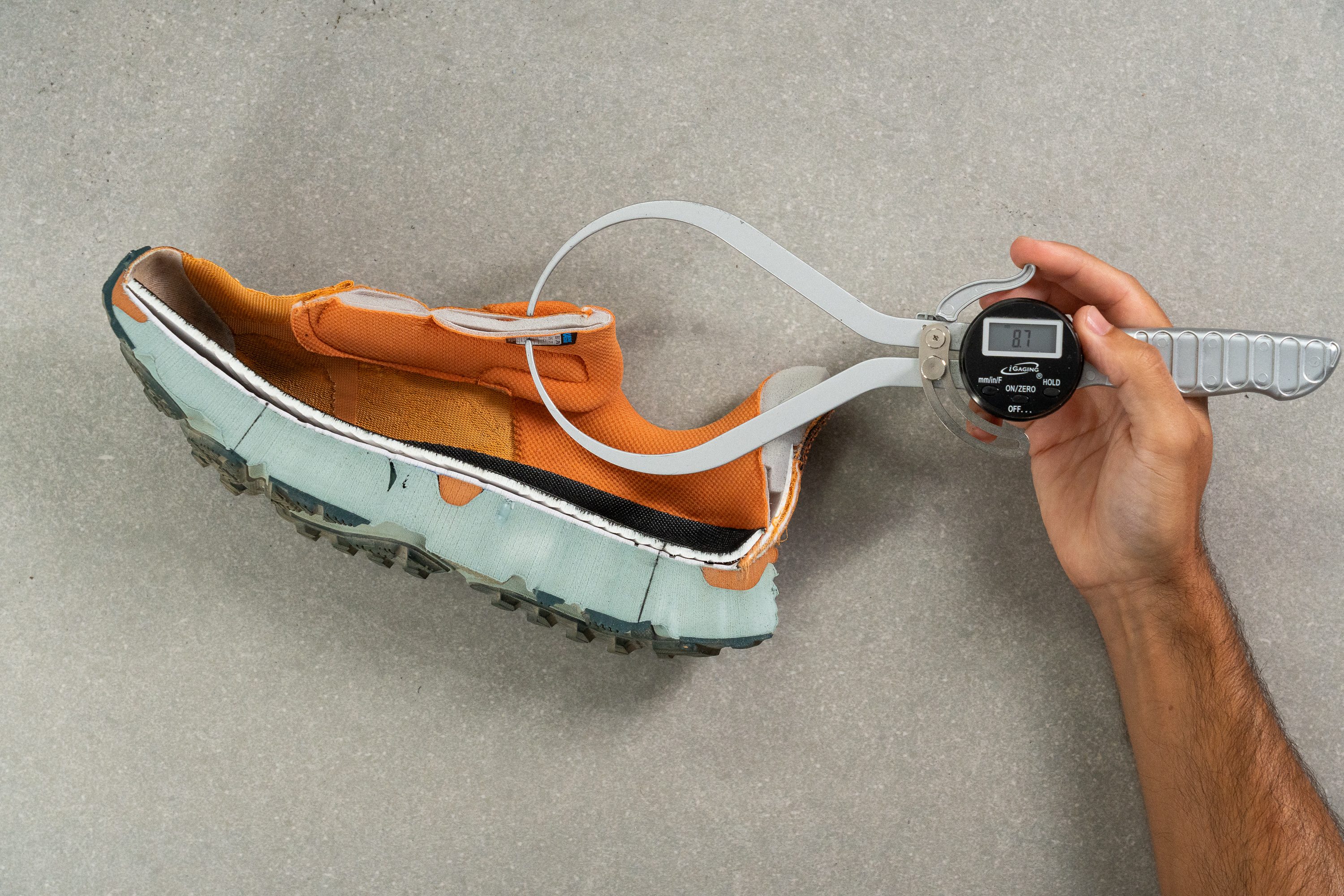
| Hoka Stinson 7 | 8.7 mm |
| Average | 6.4 mm |
Tongue: gusset type
The Stinson 7 features a semi gusseted tongue which is secured only on the medial side. This is unusual as trail shoes typically use fully gusseted tongues to avoid debris making its ways into the shoe. Once laced up, however, we felt well insulated in the Stinson 7 and didn’t have to stop and pull out any rocks or twigs during our runs.
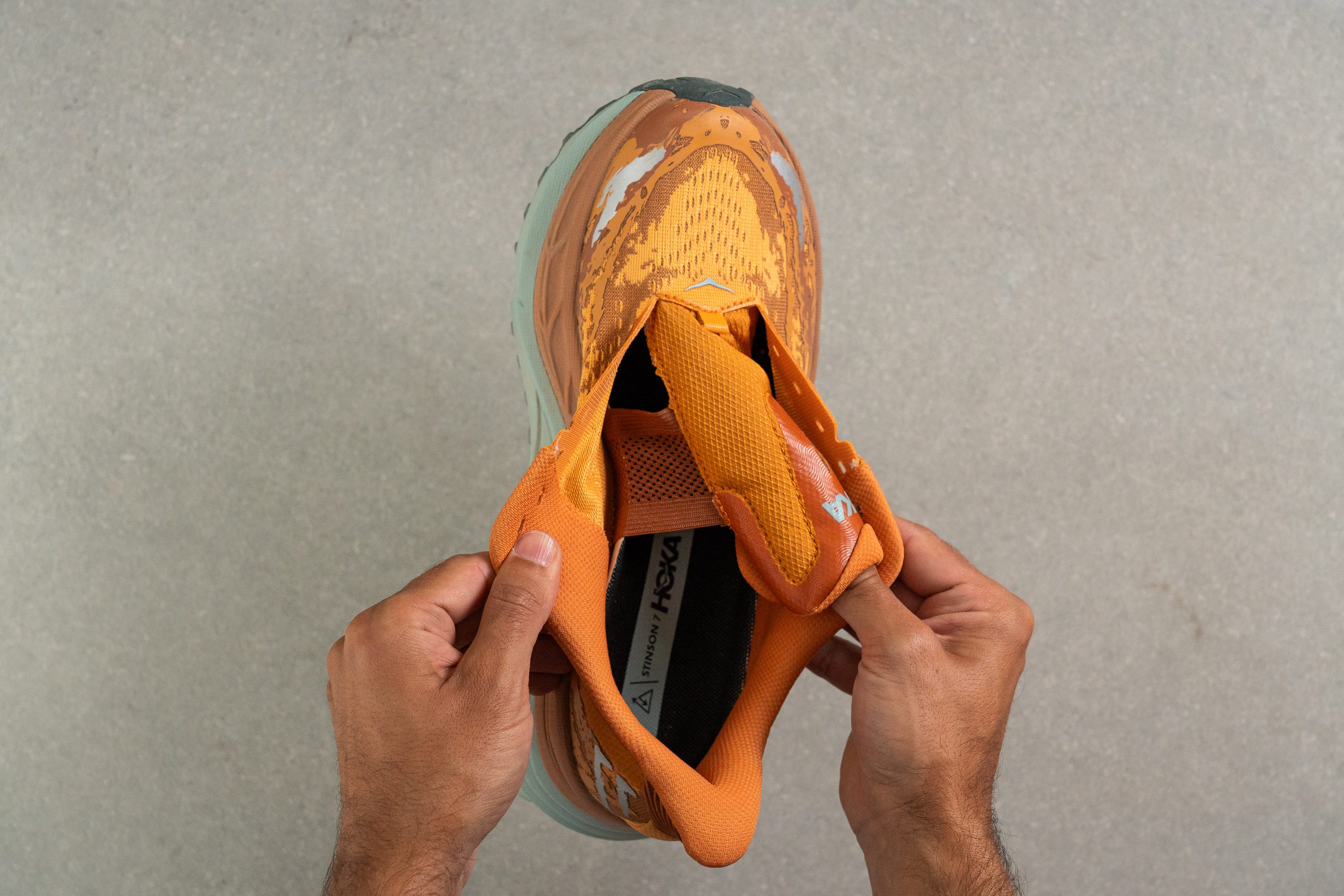
| Hoka Stinson 7 | One side (semi) |
Heel tab
While the Stinson 7 doesn’t feature a traditional finger loop, the heel flares upwards like a sort of elf-ear tab which aids in sliding the shoe on and off. On the other hand, that shape is a little too inviting to little bits of debris that can easily get scooped in.

| Hoka Stinson 7 | None |

















































